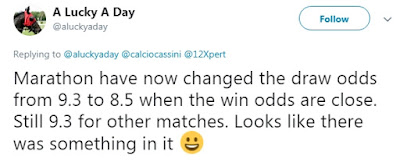There was a subsequent 'clarification' Tweet from RJ Bell this morning on the subject of 'big' favourites in the MLB and 'big' favourites in the NFL, although RJ has now changed 'big' to 'biggest':
There are no PW = 0.95 in baseball - we all know -1500s will win more than -400s. Doesn’t mean they are more profitable.-400 favourites should win approximately 80% of the time. -1500 favourites should win approximately 93.75% of the time. Essentially getting excited over the fact that 93.75 is greater than 80 isn't helpful. Yes, we all understand that there will be more winners at evens than at 2/1 than at 3/1 than at 4/1 and so on - it's how probability (usually) works.
I say 'usually' because there's one mathematical genius claiming the ability to consistently find 2.8 winners 60% of the time out there. He blocked me, which is easier to do than provide a logical reason why this freak of probability might make any sense, but Jason gets his nonsense, calling our friend out on his 'mumbo-jumbo', his lack of understanding about independent events, the 'cost of doing business', what an equity curve is, and just basic probability really. It should shock me that so many people think that using big words can give someone an edge, but I've been here a while and there are a lot of gullible people out there lacking the ability to see through bullshit.
 |
| Small Road 'Dogs |
It's a little early to be talking about American Football but it's getting close. The College season opens on August 25th and the NFL on September 6th.
Readers will no doubt be all over the College Small Road 'Dogs strategy which has been profitable in all but two seasons this millennium, with very small losses in those two losing seasons (see left). The number of bets averages a very manageable 94 a season, with the busiest weekend of 2017 at 11 bets.
The 2017 season had 92 bets and went 53-37-2 ending with an ROI of 14.1%. The long-term ROI on 1,600 bets is 7.24%.
Something to keep an eye on, if you are so inclined, is the fortune of the Big Road 'Dogs which have turned around in the past couple of seasons after years of futility. Most College Football matches have Big Road 'Dogs so there can be a lot of selections. The ROI in each of the past two seasons is 3.6%, but 887 selections isn't practical.
+94.72 points from 536 selections, ROI 17.7%It's a great ROI%, but is close to four selections each round in that division.



















